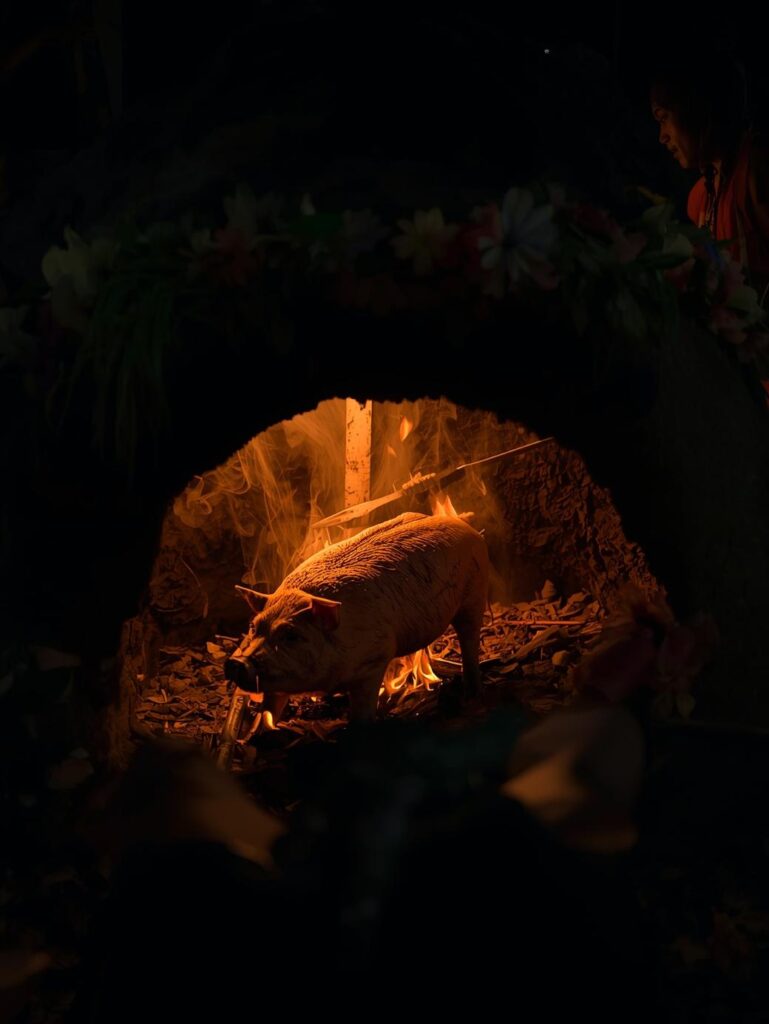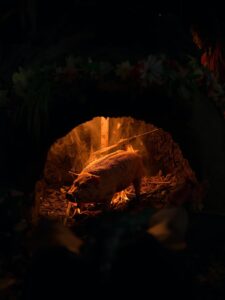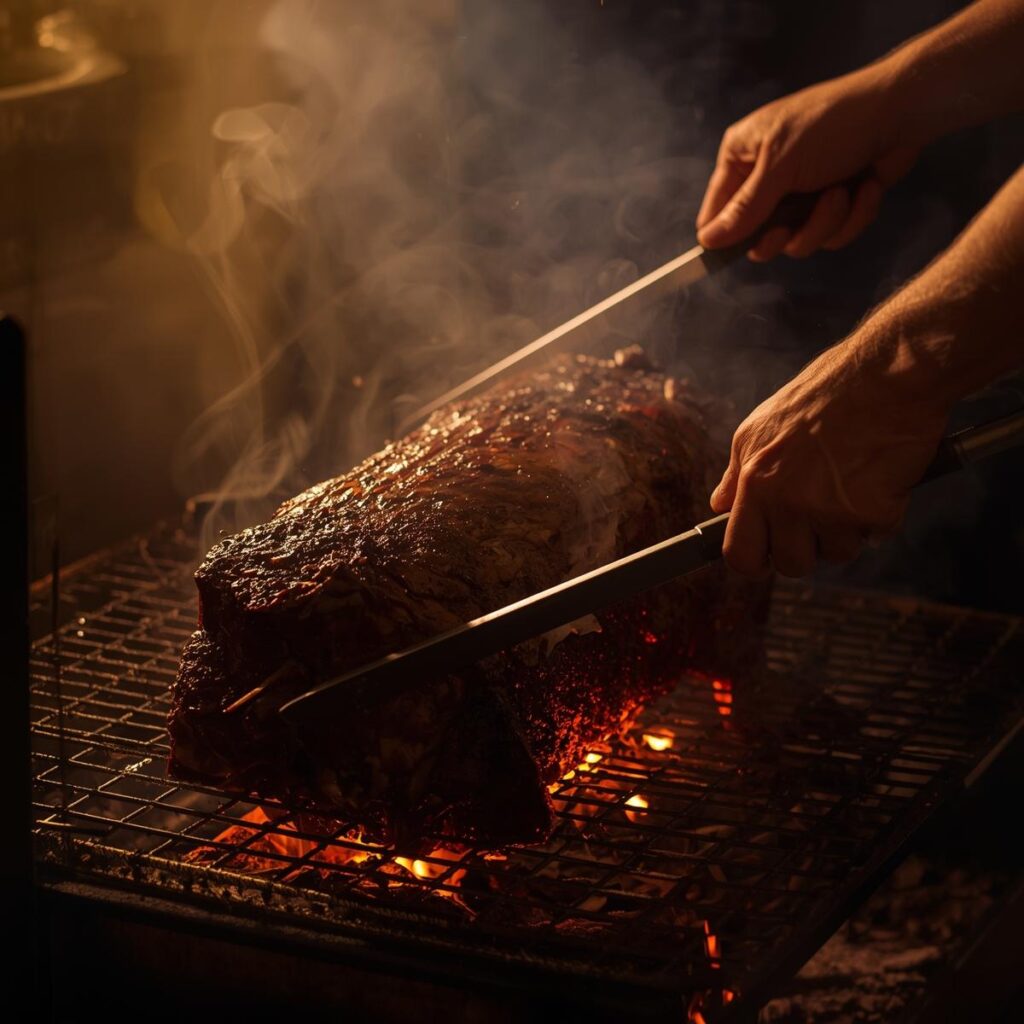Pacific BBQ Expert’s Note: This guide continues our global BBQ series with one of the world’s most ancient and spectacular cooking methods. Hawaiian Imu isn’t just cooking—it’s a sacred earth oven tradition that transforms a whole pig into smoky, steam-infused perfection through 12 hours of underground magic. While Americans tend their smokers and Argentinians watch their asados, Hawaiians have been practicing the ultimate low-and-slow cooking for over a thousand years, using the earth itself as their oven.
Hawaiian Luau Pig: Traditional Imu Underground Oven Mastery
“While modern BBQ relies on manufactured equipment, the Hawaiian Imu proves that the most sophisticated cooking technology might just be a hole in the ground. This isn’t just roasting a pig—it’s a day-long ritual that combines fire, stone, banana leaves, and earth to create something that no smoker or oven can replicate. The result isn’t just ‘kalua pig’—it’s the taste of Hawaiian culture, history, and community in every tender, smoky bite.”
Hawaiian Luau Pig: Traditional Imu Underground Oven Mastery
Download the Imu Preparation Timeline & Banana Leaf Source Guide
Aloha and welcome to the world of Hawaiian Imu cooking—where the earth becomes your oven and a whole pig transforms into the centerpiece of celebration. This ancient Polynesian cooking method, brought to Hawaii over a thousand years ago, represents the ultimate expression of “low and slow”—cooking that relies on geothermal principles rather than modern technology. This guide will take you through the sacred process of creating an Imu, from selecting the stones to the dramatic uncovering ceremony, teaching you a cooking method that’s as much about community as it is about cuisine.
🎯 THE IMU PHILOSOPHY: COOKING AS CEREMONY
Understanding Imu means embracing ritual, patience, and connection to the ‘āina (land).
⚙️ The Four Pillars of Hawaiian Imu Culture
Community, Earth, Fire, and Time
- The Community Effort: Traditional Imu cooking is never a solo endeavor. It requires a team—someone to dig, someone to gather wood and stones, someone to prepare the pig, and many hands to layer the Imu properly. The process builds ‘ohana (family) bonds.
- Respect for the ‘Āina (Land): The Imu represents a sacred relationship with the earth. The hole is dug with intention, the stones are selected carefully, and everything is returned to the earth respectfully after cooking.
- The Transformation Magic: The Imu doesn’t just cook food—it transforms it through multiple cooking methods simultaneously: radiant heat from stones, steam from wet leaves, and smoke from the wood create a unique triple-threat cooking environment.
- Ceremonial Significance: From ancient times, the Imu has been central to important celebrations—births, marriages, victories. The uncovering of the pig is a dramatic, celebratory moment that marks the beginning of feasting.
🎯 Imu vs. Modern BBQ: The Cooking Method Spectrum
🇺🇸 Modern Smoker BBQ
- Metal equipment
- Air/smoke circulation
- Dry heat environment
- 6-18 hour cooks
- Individual effort
🇺🇸 Hawaiian Imu
- Earth oven
- Steam/heat conduction
- Moist heat environment
- 8-14 hour cooks
- Community endeavor
🔪 THE IMU LEXICON: SPEAKING THE LANGUAGE
First rule of Imu mastery: learn the terms or risk cultural misunderstanding.
🗣️ Essential Hawaiian Imu Terminology
Master the Vocabulary of Earth Oven Cooking
- Imu (The Oven): The underground earth oven itself—a pit dug into the ground, heated with stones, and used for slow-cooking.
- Kalua Pig (The Result): The smoked, steamed pork that results from Imu cooking. “Kalua” means “to cook in an underground oven.”
- Pōhaku (The Stones): The volcanic stones used to hold and radiate heat. Must be dense river rocks or lava rocks that won’t explode when heated.
- Kiawe Wood (The Fuel): Hawaiian mesquite—the traditional wood used for Imu fires. Provides intense heat and distinctive smoke flavor.
- Lāʻī (Ti Leaves): The leaves used to wrap the food. Imparts flavor and creates essential steam.
- Māila (Banana Leaves): Used to line the Imu and wrap the pig. Provides moisture and flavor.
- Ili ʻIli (The Layering): The process of layering hot stones, leaves, pig, and more leaves in the Imu.
- Wehe ʻana (The Uncovering): The ceremonial uncovering of the Imu—a moment of celebration and anticipation.
📊 The Imu Preparation Matrix: From Hole to Feast
🎯 The Complete Imu Cooking Timeline
| Stage | Time Required | Key Tasks | Team Members Needed |
|---|---|---|---|
| Imu Preparation | 2-3 hours | Dig pit, gather stones/wood, prep leaves | 3-4 people |
| Fire & Stone Heating | 3-4 hours | Build fire, heat stones to glowing | 2 people (rotating) |
| Pig & Imu Layering | 1 hour | Season pig, layer Imu, cover quickly | 4-6 people |
| Cooking Time | 8-12 hours | Steam/smoke transformation | None (patience) |
| Uncovering & Serving | 1 hour | Uncover, shred pig, serve immediately | 4-6 people |
| Total Time | 14-20 hours | Start to finish | Community effort |
🔥 THE IMU CONSTRUCTION: BUILDING YOUR EARTH OVEN
The Imu’s design is ancient physics at its most brilliant.
🎪 Step 1: The Perfect Imu Pit
Digging with Intention
- Size Calculation: For a 100-pound pig, dig a pit approximately 4x4x3 feet deep. The rule is simple: the pit should be 1.5 times wider than your pig and deep enough to accommodate stones, pig, and covering.
- Location Selection: Choose level ground away from trees and structures. Consider wind direction—you don’t want smoke blowing toward your house or neighbors.
- Soil Considerations: Clay-heavy soil retains heat better but is harder to dig. Sandy soil is easier but may require additional insulation. Avoid rocky areas that make digging dangerous.
- Safety First: Call 811 before digging to check for underground utilities. Slope the sides slightly to prevent collapse.
- The Drainage Trick: Add a thin layer of gravel at the bottom for drainage if your soil retains water.
🎪 Step 2: Stone & Fuel Selection
Choosing Your Heat Batteries
- Stone Type: Use dense, volcanic rocks or smooth river rocks. Avoid porous rocks, sandstone, or rocks from riverbeds that may contain trapped water (they can explode when heated).
- Stone Quantity: You’ll need enough stones to create a 6-8 inch layer on the pit bottom and enough to place inside the pig cavity. For a 4×4 pit, this is approximately 150-200 pounds of stones.
- Kiawe Wood: The traditional Hawaiian mesquite burns hot and long. If unavailable, use oak, hickory, or other hardwoods. Avoid softwoods like pine that create sooty smoke.
- Wood Preparation: Use split logs rather than whole rounds for more surface area and faster burning. Have extra wood on hand—you can always use it later.
- The Rock Test: Heat one test rock first. If it cracks or explodes, find different rocks.
🐖 THE PIG PREPARATION: FROM ANIMAL TO IMU READY
The pig preparation is as important as the Imu construction.
🔪 Pig Selection & Butchering
Choosing and Prepping the Star
- Size Matters: Traditional luau pigs are 80-120 pounds (dressed weight). This size fits most Imu and serves 50-80 people.
- Breed Considerations: Heritage breeds like Berkshire or Duroc have better fat distribution. Avoid super-lean commercial breeds.
- Butterflying Technique: The pig is typically butterflied—split down the belly and flattened. This creates more surface area for seasoning and even cooking.
- Bone-in Tradition: Cook with bones in for flavor. The collagen from bones and connective tissue creates amazing broth during cooking.
- Skin On: Leave the skin on—it protects the meat and becomes deliciously tender in the steam environment.
🧂 Seasoning & Wrapping
The Flavor Foundation
- Hawaiian Salt (ʻAlaea): The only essential seasoning. This red volcanic salt provides minerals and authentic flavor.
- Massage Technique: Generously rub salt inside the cavity and on the skin. Get it into every fold and muscle group.
- Liquid Smoke Debate: Purists use only salt, but some add liquid smoke to approximate the kiawe flavor if using other woods.
- Ti Leaf Wrapping: Wrap the salted pig in ti leaves if available. This imparts a distinctive flavor and creates steam.
- Banana Leaf Layer: After ti leaves, wrap in banana leaves for additional moisture and flavor. Secure with butcher’s twine.
- Wire Mesh: Finally, wrap in chicken wire for easy handling and to keep everything contained during cooking.
📋 THE IMU LAYERING CEREMONY: BUILDING THE OVEN
The 1-Hour Layering Process: Ancient Engineering
Hot Stone Base
Remove fire embers, spread glowing stones evenly across pit bottom. Wear heat-resistant gear.
Banana Leaf Layer
Quickly layer wet banana leaves over hot stones. Creates steam barrier.
Pig Placement
Place wrapped pig skin-side down. Add hot stones to cavity if traditional.
Final Layers & Cover
More leaves, wet burlap, tarps, then soil. Seal completely to trap steam.
🚨 IMU TROUBLESHOOTING: COMMON PITFALLS & SOLUTIONS
🎯 Fixing Common Imu Cooking Problems
| Problem | Hawaiian Description | Cause | Solution |
|---|---|---|---|
| Undercooked Pig | “Puaʻa maka” (raw pig) | Insufficient stones, too short cook, heat loss | More stones, longer cook, better insulation |
| Dry Meat | “Malooʻo” (too dry) | Not enough leaves, steam escape, overcooked | More wet leaves, better seal, check earlier |
| No Smoke Flavor | “ʻAʻohe ʻala” (no fragrance) | Wrong wood, stones not hot enough | Use kiawe/oak, hotter stones, longer fire |
| Dirt Flavor | “ʻOnai kele” (dirt taste) | Soil contact, poor wrapping | Better leaf layers, burlap barrier |
| Exploding Rocks | “Pahū pōhaku” (rock explosion) | Wrong rock type, wet rocks | Use volcanic/river rocks, test first |
🏁 MASTERING THE ANCIART OF IMU COOKING
Mastering the Hawaiian Imu means participating in a thousand-year-old tradition that connects you to Polynesian ancestors, the Hawaiian land, and the spirit of community celebration. This isn’t just another cooking method—it’s a culinary time machine that produces flavors no modern equipment can replicate. The smoky, steam-infused, impossibly tender kalua pig is worth every hour of effort.
Your Imu journey starts with gathering your ‘ohana—this cannot be a solo project. Then comes the physical work of digging, stone gathering, and fire tending. Finally, you’ll experience the magic of the uncovering ceremony, where steam and incredible aromas erupt as you reveal the transformed pig. The shared effort makes the feast taste even better.
So gather your crew, find your stones, and remember the three rules of Imu mastery: respect the process, work as a community, and trust the ancient wisdom of the earth oven. Your journey to becoming an Imu master starts now.
🏝️ START WITH OVEN KALUA PIG →
Master the flavors of kalua pig using your home oven before attempting the full Imu method
Explore More Pacific Island Traditions: Continue your journey through Oceania’s fire traditions.




